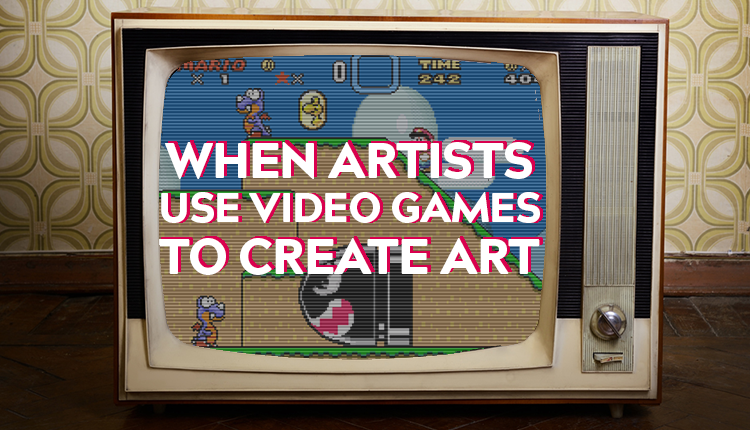Inside the general, online-gaming community, one can observe that when games and art are discussed, videogames are predominantly used as the lens through which the conversation is anchored. Still, we can discern the connection between art and games with greater depth if we reverse our perspective. That is exactly what Chapter 3 of John Sharp’s Works of Game sets out to do: describe the methods by which artists approach videogames to make their own game art. In doing so, we find different groups who use games to create visual art, who modify games to create cultural commentary, and artists who wish to reflect on the medium itself.
To better understand how games are used in the art world, it is useful to elucidate their role in altering current interpretations of art. As far back as the 60s, artists such as Takako Saito used chess as a central theme in his work. Yet, in his exhibits, the game wasn’t playable but was employed instead to illuminate the relationships between different objects on the board.

This approach “was part of the sea [of] change that began with conceptual art and its privileging of ideas over form.” In this school of thought, there is little value assigned to how the ideas are made manifest, but rather the idea behind the work is the prime mover. In a sense, art could be made of anything. Just see Duchamp’s Fountain.
Herein lies Sharp’s first example of game art: the artists who use gaming technology as tools for art creation. Artist John Oliver’s ioq3aPaint perfectly illustrates this approach. Oliver manipulated bugs in the Quake 3 engine to create abstract images. The resulting screengrabs had zero “gameness left [and shared] no obvious connection to games at all if the viewer was not familiar with how videogames were made.”

In Sharp’s eyes, this method of repurposing game technology for art creation is analogous with the works of Ben Laposky who aesthetically explored images captured by electronic test instruments. Sharp goes further and places Oliver’s style in the historical trajectory of Robert Rauschenburg, whose paintings were “not a conception of what the world looked like, but rather what the world was.”
The image to the left is a contemporary example of game art. The artist is Ygor Dimas and you can find his work on Twitter or Ello.
Nevertheless, artists enlist games as materials for art creation in more elastic practices than just image creation. Some artists use games to subvert the original creation and create commentary. Sharp highlights Cory Arcangel, who repurposes games in his own works, to exemplify this approach. He created Beat the Champ, an installation that displayed ten bowling games from different eras all auto-rolling gutter balls. By removing play, Arcangel subverts the original games’ intention.

Furthermore, Sharp points out the similarities between Arcangel’s Beat the Champ and Andy Warhol’s Campbell’s Soup Cans. With Campbell’s Soup Cans, Warhol denied the images of their advertising power and replaced it with commentary on the “commerce driven nature of fine art [galleries].” Likewise, Beat the Champ changes the frustration of a gutterball into a pleasurable viewing experience. Both appropriate artifacts with the intention of creating new meaning while at the same time stripping them of their characteristics that were present before intervention.
Lastly, Sharp shows that artists also use games to reflect upon and even research or expose the medium. Here, the artists wish to bring a “critical eye to… videogames, their play, and the technologies that produce them.” Max Payne Cheats Only 1, a compilation of videos showing exploits and graphical glitches in Max Payne 2, has lost its interactivity, allowing the viewer to “contemplate the bizarre, artificial nature of 3D games.”
Tangentially, the creator of Cheats Only 1, JODI, also made Cadavre Exquis, or exquisite corpse. JODI presents a sheet of folded paper as a game to produce a drawing. The first “player” draws an image on the section displayed to them, and the subsequent “players” fill in their panel by connecting the lines from the previous fold. The resulting unfolded sheet is a mish-mash of images that create no coherent statement or idea. Instead, “the process of playing the game becomes the meaning of the work.”
Ultimately, the viewer knows “the real experience of the image is forever gone and understood only by those who actively participated in the game.”
(I cannot begin to describe how revelatory I felt reading that statement, as it perfectly encapsulates my attitude towards gameplay. The true joy of games is found in the transient play that is necessary to experience them.)
So there you have it, this is how videogames and art are approached by those who come at games with an “art-first” perspective. The tools of game creation can be repurposed for the sake of creating visual art, or mods can be made that overthrow the work’s intended purpose and create commentary. Nevertheless, what I find most interesting here is when artists modify videogames in order to better understand them. If artists are okay stating that the process of play is meaningless, why do we hold so tightly to the notion that playing games is important?
All ideas in this article were pulled from Works of Game: On Aesthetics of Game and Art. More specifically, chapter 2.
Edited by Malia Hamilton
Originally published on OK Beast
